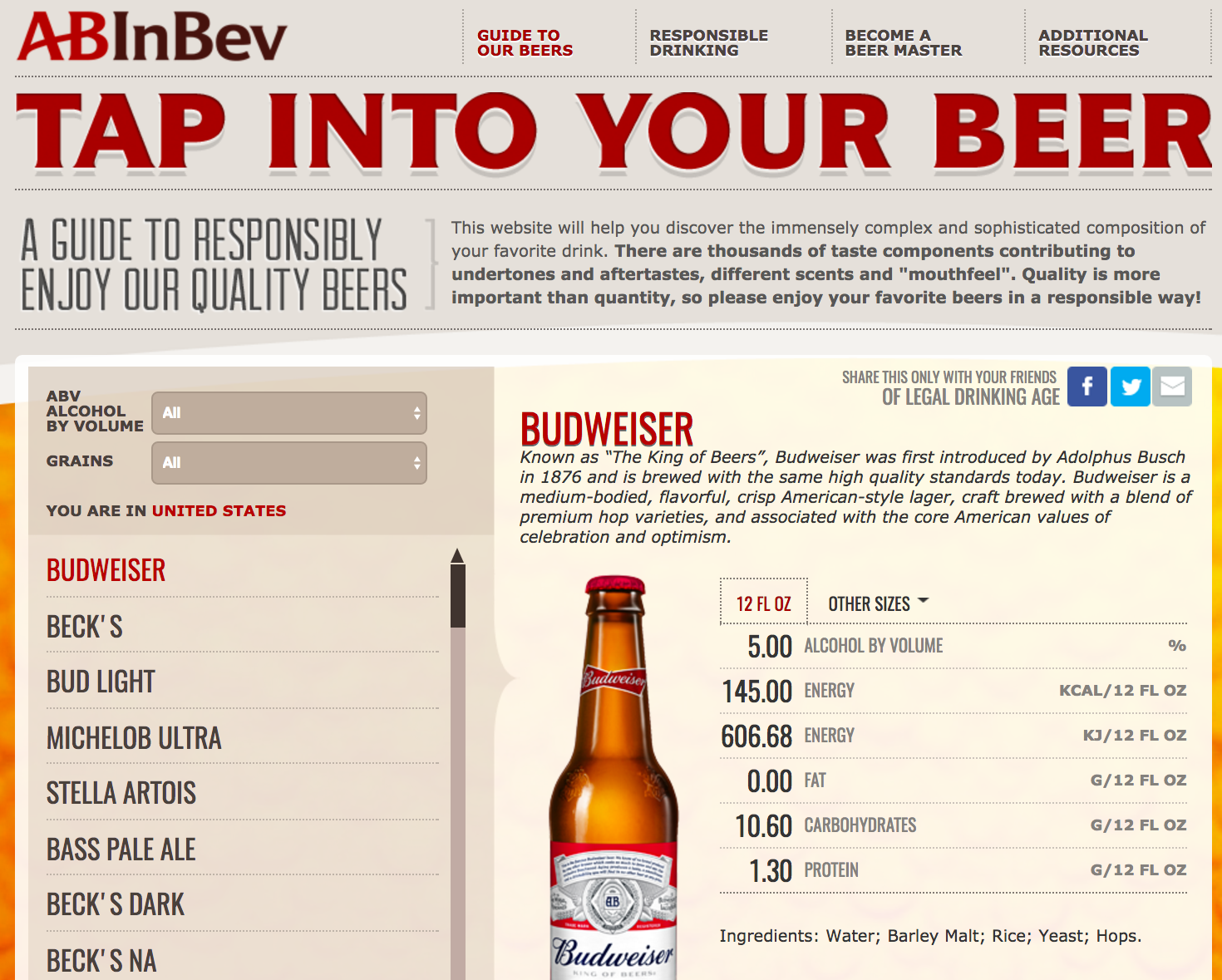The Nutrition of Beer
A young man tries to identify the contents of a bottle of Budweiser.
Speaking at Anheuser-Busch on The Nutrition of Beer. The 12th of April, 2017 at their Chelsea office.
What's in this can?
Pick up a can of beer, a bottle of wine or a handle of liquor. Do you know what's inside? No ingredient list, no nutrition facts. Nada. Peculiar, no?
Quite strange considering that every non-alcoholic beverage provides this information. The US Food and Drug Administration, the FDA, requires that all food and beverage manufacturers disclose the ingredients in their products. Is beer not a beverage?
The discrepancy rests in a division of oversight. The FDA regulates all products of consumption in the United States, except for two: alcohol and cigarettes. These products are regulated by a different entity called the Alcohol and Tobacco Tax and Trade Bureau. This bureau does not require ingredient disclosure, hence the absence of this information.
Given the lack of nutritional disclosure, it's no wonder that Joe America has no idea what he's actually drinking. The nutrition of beer, and alcohol in general, remains quite mysterious to the American public.
This post will explore a neglected topic: the nutrition of beer.
Is beer nutritious?
Before you scoff at a seemingly ludicrous question, think critically. The answer to this question is quite profound and may surprise you.
"Nutritious," by definition, means containing nutrients. So, technically speaking, yes beer is nutritious.
However, there is an important distinction between nutritious and healthy. Nutritious refers to the presence of nutrients whereas healthy signifies a positive impact of those nutrients on the body. What's healthy for one person may not be healthy for another. Healthy is not an absolute term. Is beer healthy? Well, this fascinating question is beyond the scope of this week's post.
What is the main source of calories in beer?
Alcohol is the main macronutrient in beer and the largest contributor of calories. A macronutrient is something that contains calories and is consumed in large quantities in the diet. Every gram of alcohol contributes 7 calories.
What is the second largest contributor of calories in beer?
Carbohydrates! Yes, these carbohydrates come from the grain used to produce the beer. Every gram of carbohydrates adds 4 calories to the total caloric content. This is an important point--and a common macronutrient misconception--alcohol is not a carb. Alcohol and carbohydrate are two different chemical compounds producing distinct effects on the body. Carbohydrates raise blood sugar, whereas alcohol does not.
What are the other two types of macronutrients?
Fat and Protein.
Does beer contain fat?
No! Beer is fat free.
Does beer contain protein?
Yes! 1-2 grams of protein per serving of beer.
Where does the protein come from?
The grain. The protein represents the energy reserve needed by a seed to grow into a plant. Another name for this protein is gluten. Yes, gluten is protein! And yes, if you choose a product that has been processed to remove gluten, you have lowered the protein content of what you're eating. So, think twice about the gluten free option if you don't have wheat allergy, celiac disease or gluten sensitivity.
What about micronutrients?
Micronutrients don't contain calories and are consumed in small quantities in the diet. Vitamins, minerals and other plant chemicals are micronutrients.
Beer contains several B vitamins, including B1 [Thiamine], B2 [Riboflavin] and B9 [Folate].
Beer also contains calcium and magnesium.
Beer contains an important element not contained in wine. What is it?
Silicon. You might remember this guy from your chemistry class. Number 14 on the Periodic Table.
A diet rich in silicon is associated with prevention of which disease?
Osteoporosis (Casey et al.).
To appreciate the nutrition of beer more deeply, it's necessary to explore the ingredients added to produce beer.
What are the 4 main ingredients in beer?
Grain, water, hops and yeast.
What's the most commonly used grain?
Barley. Wheat is at a distant second.
Is all water created equal?
Compare a bottle of Dasani to a bottle of Fiji to a bottle of Evian. None of these is identical. These waters differ based on their micronutrient content. They have different amounts of ions and minerals. The mineral content depends on the source of the water, based on the mineral content of the springs from which the water is bottled. Differences in mineral content change the taste of the water. From a manufacturing standpoint, this can pose a challenge in maintaining uniformity of the product. For instance, if an American manufacturer opens a brewery in Australia, the Australian water would need to be treated so that the starting water matches its American counterpart. Otherwise, the two beers will taste different.
What are the two main reasons hops is added to beer?
Preservation and flavor.
As a preservative, hops acts to prevent growth of undesirable bacterial populations. Many microorganisms contribute to the brewing of beer and hops acts as a natural antibiotic. Interestingly, just as bacteria in the human body is developing resistance to antibiotics, so too, are bacteria developing resistance to hops.
As flavor, hops adds bitterness to beer.
Why would brewers add bitterness to beer?
The bitterness of hops balances the sweetness of the sugars. These sugars come from the grain. The malting process converts complex carbohydrates into simple sugars that can be used by the yeast.
What's the function of yeast?
Yeast perform fermentation.
What is fermentation?
Fermentation is the process by which yeast converts sugar into alcohol. Speaking plainly, sugar is food for the yeast and the alcohol is their waste product. Yum!
Fermentation transforms the starting ingredients into the final product. Fermentation transforms the nutrition of beer.
The more fermentation that occurs--the longer the malt is allowed to ferment, the more sugar contained within the malt, the more yeast added to the brew--the higher the alcoholic content and the lower the carb count.
Does yeast need to be added to brew beer?
Added? Technically no. Yeast is omnipresent in the environment. Yeast covers the surfaces around you. Yeast is suspended, floating through the air. Yeast is everywhere. The first beer that was brewed--records date back 7,000 years ago in Persia--happened spontaneously from yeast present in the environment. Fermentation is the decay process by which living materials are broken down.
Why is yeast added?
Yeast are added for two reasons: to expedite brewing and to control the type of beer produced.
Rather than awaiting spontaneous fermentation, adding yeast to malt accelerates the conversion of sugar to alcohol.
Second, adding yeast allows for control over which yeast will perform the fermentation. Certain species of yeast yield ales, whereas others produce lagers.
The beer of nutrition has been mysterious for decades, but that may soon change.
In July 2016, the Beer Institute announced that several beer manufacturers, including Anheuser-Busch, will voluntarily list nutritional information on beers by 2020. This decision is known as the Voluntary Disclosure Initiative. Voluntary because the Alcohol and Tobacco Tax and Trade Bureau doesn't require alcohol manufacturers provide this information.
Why the change?
This nutritional transparency targets the up-and-coming target beer consumers: the millennials. The youngest beer consumers are increasingly aware of their dietary decisions. They’ve witnessed a wave of diabesity afflicting their baby-boomer parents. Millennials understand the importance of their dietary decisions and want to avoid preventable diseases like diabetes, high blood pressure, high cholesterol and obesity.
Millennials want to know what they are consuming.
In the meantime, tapintoyourbeer.com offers some nutritional information on A-B beers.
Resources
Bamforth, C.W. "Progress in Brewing Science and Beer Production". Annual Review of Chemical and Biomolecular Engineering. 8 March 2017. 8:8.1-8.16.
www.beerinstitute.org/policy-issues/voluntary-disclosure/
Bokulich, Nicholas A. and Charles W. Bamforth. "The Microbiology of Malting and Brewing" Microbiology and Molecular Biology Reviews. June 2013. Vol 77, No 2.
Casey et al. "Silicon in beer and brewing". Journal of the Science of Food and Agriculture. February 2010.
www.consumeraffairs.com/news/anheuser-busch-adds-beer-nutrition-information-to-its-website-061214.html
www.fda.gov/Food/GuidanceRegulation/GuidanceDocumentsRegulatoryInformation/LabelingNutrition/ucm166239.htm
Hucker, Barry et al. "The Quantitative Analysis of Thiamin and Riboflavin and Their Respective Vitamers in Fermented Alcoholic Beverages". Journal of Agricultural and Food Chemistry. 2011, 59, 12278-12285.
www.iard.org/policy-tables/beverage-alcohol-labeling-requirements/
Marco, Maria L et al. "Health benefits of fermented foods: microbiota and beyond". Current Opinion in Biotechnology. 2017, 44: 94-102.
www.tapintoyourbeer.com/index.cfm?id=642
www.ttb.gov/beer/index.shtml



